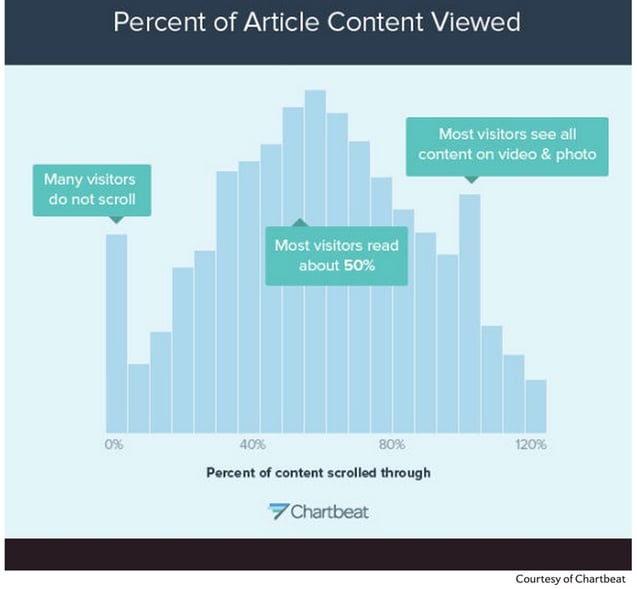SCROLL, Dang It! Why Don't You Scroll?

Content creators and those who genuinely care about website page content will be extremely disappointed to hear the following news: Even those who click into your content are unlikely to read it all... and in a significant number of cases, they won't scroll at all.
There are some great tools out there that will give you visual evidence of where folks are clicking on your website (heatmaps) and others that will record the interactivity of those consuming your content. The results are not only very informative about human behavior and interaction with your website, but also can be quite alarming in showing how little of your content visitors are willing to consume.
Slate.com recently charged Josh Schwartz, a data analyst at the traffic analysis firm Chartbeat, to explore how readers engage with its articles as well as with the content of several other sites. The results are eye-opening.
If we can use this research as at least a general reflection of user behavior, what we can expect is that 38% of those that land on our content will "bounce," failing to really consume the information at all. They certainly won't scroll, and rarely stick around more than a few seconds. In fact, the majority of visitors will consume an average of about 50% of your content, and few will actually stick around long enough to consume an entire article or blog post.
It's easy to postulate that the main reason is the low attention span and easily distracted nature of today's consumers (and there's undoubtedly significant truth in that). It's also simply a matter of fact that increasingly, reading is something that many surfers are loath to do, so a simple scan for graphics and bulleted lists is all one can hope for.
But there are nonetheless some things that you CAN do to increase the readership, even if your product or service is relatively "boring" in nature:
- Avoid jargon, and technical speak.
- Speak in terms that your target buyer personas care about and avoid talking about what YOU care about.
- Make sure the content is instructive or helpful rather than salesy.
- Let your personality come out and avoid formal-speak. Humor is always more likely to hold interest.
- Make your titles pithy, intriguing, or enticing. Use numbers in the title as often as possible, e.g. 5 Cheap Tips That Will Make Your Lawn Greener.
- Use infographics or images to help tell the story.
- Use storytelling and parables. It's a formula that has proven effective for at least 2000 years.
- Keep it brief, and use bullet-points and lists whenever possible. Articles and blog posts should most often be between 300 and 500 words.
We may not be able to force our website visitors to consume all of our content. (And okay, I'll confess that yelling at them to scroll is probably not the way to go about trying to change their behavior.) But, come on! Scroll! There's some great content down here at the bottom!!!



